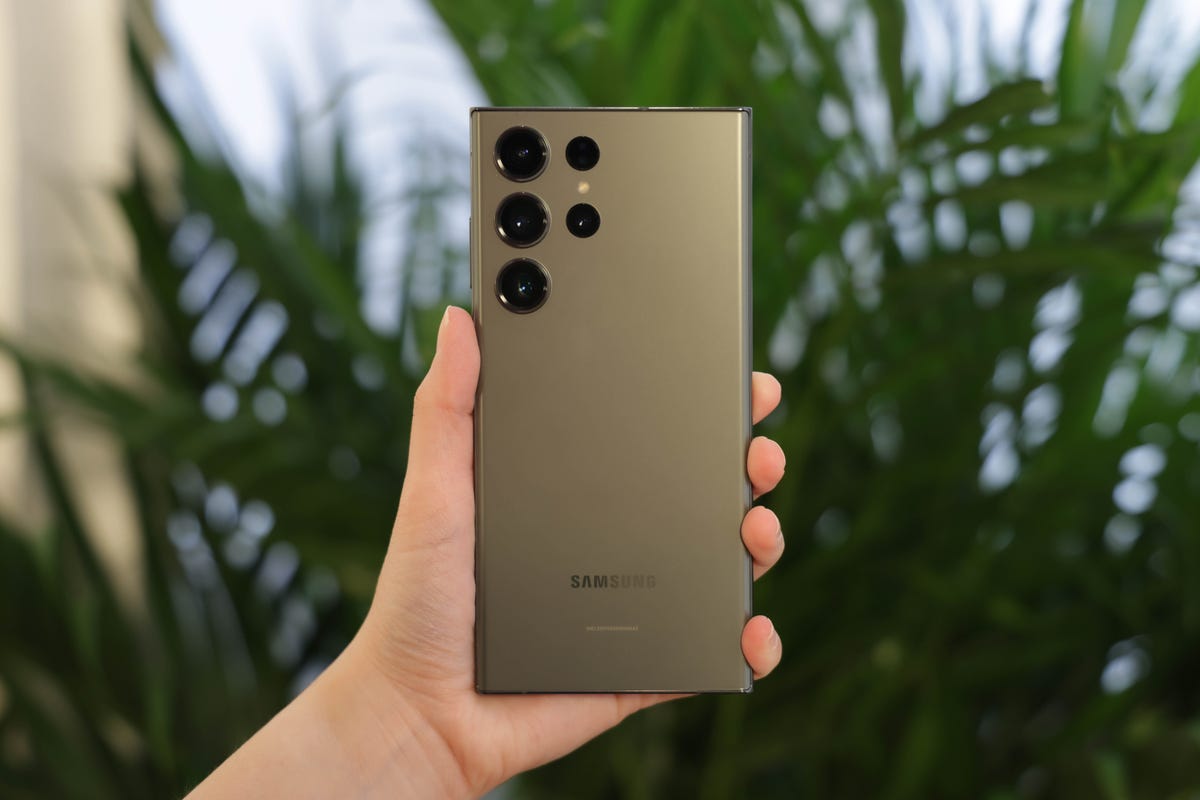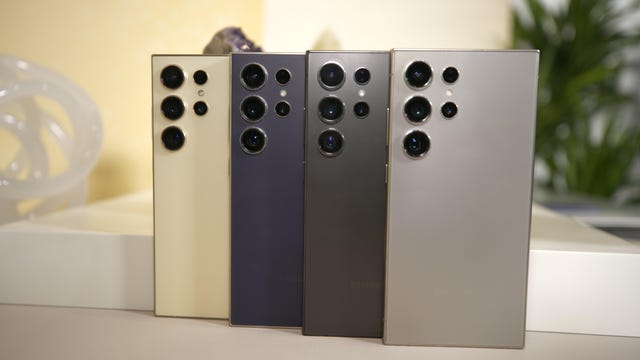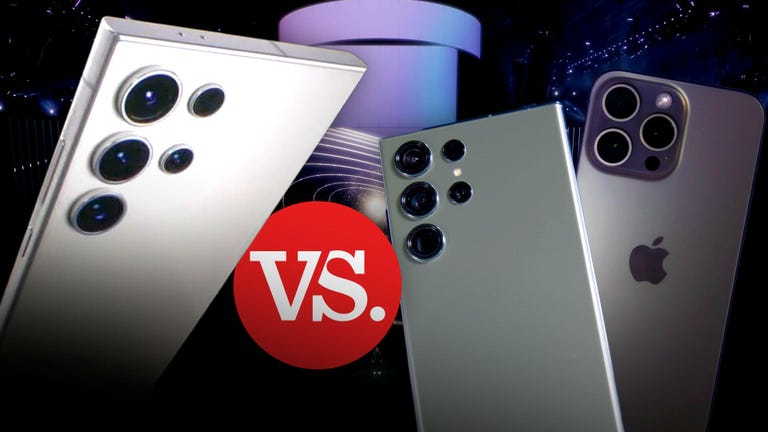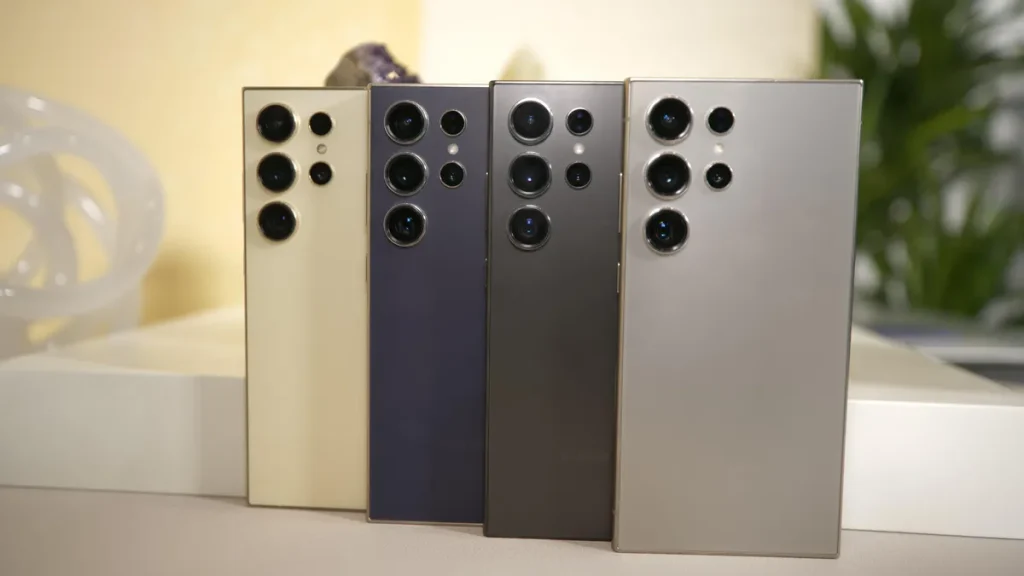Samsung unveiled its newest Galaxy S24 phones at its Unpacked event. The most premium of the lot is the Galaxy S24 Ultra, which has several new features over last year’s model. What’s changed from the S23 Ultra, and should you upgrade? Probably not, but let me explain.
First, here’s what’s changed. The S24 Ultra has a nominal amount of upgrades on its predecessor (mainly under the hood), but is pricier, starting at $1,300, while the S23 Ultra had a $1,200 price tag at launch (and can probably be found for cheaper now).
Read more: Best Android Phone of 2024
The S24 Ultra visually looks identical to its predecessor, with broadly the same design and rear camera layout. There are subtle differences. For instance, Samsung’s new high-end phone has a titanium frame, which should be tougher than the aluminum frame on the S23 Ultra.
For the S24 Ultra, Samsung dispensed with the curved edges of the display found on the S23 Ultra, leaving a flat front (Samsung claims it has 47% less bezel on the sides). That new screen is also brighter with a maximum of 2,600 nits (the S23 Ultra maxed out at 1,750 nits) and thus easier to see in bright daylight. The S24 Ultra’s screen is also made of Corning’s newest and toughest material, Gorilla Glass Armor, while the S23 has Corning’s Gorilla Glass Victus 2.
In short: it looks the same but should be tougher and have a potentially brighter screen. The S24 Ultra also has an improved cooling system with a vapor chamber that’s twice as large and two added layers of thermal insulation, so we’d expect it to maintain better framerates and temperatures when running performance-intensive operations, like gaming.
As for cameras, the S24 Ultra inherits most of its predecessor’s lenses and sensors but does use a 50-megapixel 5x optical telephoto camera in place of the 10-megapixel 10x optical camera in the S23 Ultra. While the new camera has a shorter optical length, its higher megapixel count should mean photos taken with it are sharper than those shot with the S23’s 10x optical camera. (We’ll know for sure when we can compare both phones’ photo capabilities side by side.) To get to 10x optical length, the S24 Ultra shoots with its 5x optical camera and crop zooms in.
Read more: Samsung Galaxy S24 Phones Have a New Zoom Trick to Get That Close-Up Photo
The S24 Ultra is powered by a Snapdragon 8 Gen 3 chipset, which is faster than the Snapdragon 8 Gen 2 in the S23 Ultra. Configurations have also been simplified in the new premium phone: you can only get 12GB of RAM and 256GB, 512GB or 1TB of storage (no 8GB RAM option, as there was in the S23 Ultra). The rest of the hardware remains relatively unchanged, although the S24 Ultra should get a minor battery efficiency boost thanks to its newer chipset.

The big difference between the new phones, at least at the launch of the S24 Ultra, is the new phone’s generative AI capabilities, called Galaxy AI. The most noteworthy is Circle to Search, which lets you trace an area on your screen with your stylus or finger to have your phone look up what you’ve circled without ever having to leave the app you’re in. It’s conceivably great for looking things up, like identifying landmarks in the travel photos your friend sends over or trying to track down fashion items in someone’s outfit.
The S24 Ultra (and the rest of the S24 lineup, to be clear) has other generative AI capabilities, like summarizing notes and live translations during phone calls. It can also suggest different tones for text messages depending on who you’re talking to, recommending more formal tones for bosses or casual tones for friends. Generative AI photo tricks let users do things like move or delete some elements, expand photos beyond their original boundaries or correct the tilt of an image, then use AI to fill in the backgrounds and empty areas.
Some of these generative AI features can be processed locally, like live translation, while others require sending requests to the cloud. The S24 Ultra does have a toggle in its settings to require generative AI requests to be performed on the device, which helps keep what you’re asking (and what your phone is addressing) private.
The kicker? Galaxy AI is coming to some older Samsung phones, including the S23 series, at some point in the future. While Samsung hasn’t said when to expect them, these features should come to the S23 Ultra in time.
There are other non-generative AI upgrades the S24 Ultra has over its predecessor, like making photos more stable during movement and improving low-light photography. The S Pen accessory is more or less unchanged from last year.
There is one more upgrade that’s worth mentioning: Samsung expanded how long it’s pledging to support its newest phones. The S24 Ultra comes with Android 14 and will get seven years of Android software and security patches, up from four years in the S23 Ultra (which comes with Android 13). That’s big. For sustainability, the S24 Ultra has more recycled parts, including cobalt in its battery and rare earth elements in its speakers.

Should S23 Ultra owners upgrade to the new S24 Ultra?
You can count the hardware improvements on one hand and they don’t meaningfully change how owners use their new S24 Ultra compared to last year’s S23 Ultra. Ultimately, if you own Samsung’s premium phone from 2023, the only reason you to consider upgrading to the new one is to access generative AI today — or if you wanted a phone that could conceivably last you seven years.
As previously mentioned, all the Galaxy AI features are expected to come to the S23 Ultra at some point in the future. It’s unclear when that will happen, and though Samsung said all of the S24 Ultra’s generative AI features will come to its predecessor, we’re concerned whether last year’s premium phone can pull that off.
Last October, Qualcomm unveiled its Snapdragon 8 Gen 3 as the first phone-powering chipset to include generative AI on its silicon. That’s the chip powering the S24 Ultra, and presumably, the new phone needs that silicon to process some of its generative AI features. Either the S23 Ultra will require more of those Galaxy AI features to run through the cloud, or the Snapdragon 8 Gen 2 powering the S23 Ultra is actually capable of running on-device generative AI, but those features weren’t ready when that chipset launched in late 2022.
Whatever the case, whether you want generative AI weighs more heavily than any other factor on whether it’s worth upgrading from the S23 Ultra to the new S24 Ultra. It’s worth noting that we haven’t gotten to thoroughly experience Galaxy AI ourselves, and can’t make a summary judgment of its usefulness until we do. Once our full review comes out, we’ll be better informed to say whether the S24 Ultra provides a superior experience to its predecessor. For now, we recommend waiting — unless you want to be on the absolute cutting edge of mobile technology.
Samsung’s Galaxy S24 Ultra Now Has a Titanium Design


Now Playing: Samsung Galaxy S24 Ultra vs. Galaxy S23 Ultra vs. iPhone 15 Pro Max (Flagship Phones Compared)
10:31
Samsung Galaxy S24 Ultra specs vs. Samsung Galaxy S23 Ultra
| Samsung Galaxy S24 Ultra | Samsung Galaxy S23 Ultra | |
| Display size, tech, resolution, refresh rate | 6.8-inch AMOLED; 3,120×1,440 pixels; 1-120Hz adaptive refresh rate | 6.8-inch AMOLED; 3,088×1,440 pixels; 120Hz adaptive refresh rate |
| Pixel density | 501 ppi | 500 ppi |
| Dimensions (inches) | 6.40 x 3.11 x 0.34 in | 6.43 x 3.07 x 0.35 in |
| Dimensions (millimeters) | 163 x 79 x 8.6 mm | 163.3 x 78 x 8.9 mm |
| Weight (grams, ounces) | 233 g (8.22 oz) | 234 g (8.25 oz) |
| Mobile software | Android 14 | Android 13 |
| Camera | 200-megapixel (wide), 12-megapixel (ultrawide), 10-megapixel (3x telephoto), 50-megapixel (5x telephoto) | 200-megapixel (wide), 12-megapixel (ultrawide) 10-megapixel (3x telephoto) 10-megapixel (10x telephoto) |
| Front-facing camera | 12-megapixel | 12-megapixel |
| Video capture | 8K | 8K |
| Processor | Qualcomm Snapdragon 8 Gen 3 | Qualcomm Snapdragon 8 Gen 2 for Galaxy |
| RAM/storage | 12GB RAM + 256GB, 512GB, 1TB | 8GB RAM + 256GB; 12GB RAM + 256GB, 512GB, 1TB |
| Expandable storage | None | None |
| Battery | 5,000 mAh | 5,000 mAh |
| Fingerprint sensor | Under display | Under display |
| Connector | USB-C | USB-C |
| Headphone jack | None | None |
| Special features | Titanium frame, 2,600-nit peak brightness; 7 years of OS and security updates; 5G (mmWave); IP68 water resistance; wireless PowerShare to charge other devices; integrated S Pen; UWB for finding other devices; 45W wired charging (charger not included); Galaxy AI; Wi-Fi 7; Gorilla Glass Armor cover glass | 4 years of OS updates, 5G (Sub6, mmWave); IP68 water resistance; wireless PowerShare to charge other devices; integrated S Pen; 100x Space Zoom; 10x optical zoom; UWB for finding other devices; 45W wired charging |
| US price starts at | $1,300 (256GB) | $1,200 (256GB) |
| UK price starts at | £1,249 (256GB) | £1,249 (256GB) |
| Australia price starts at | AU$2,199 (256GB) | AU$1,949 (256GB) |
